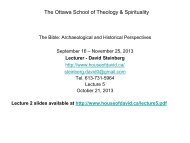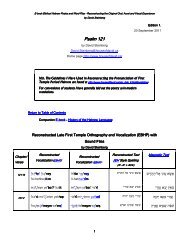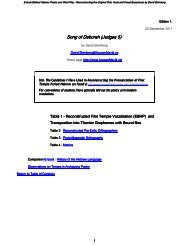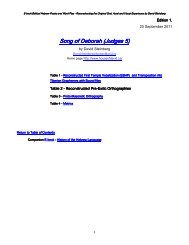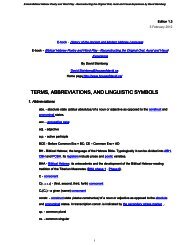Biblical Hebrew Poetry - House of David Steinberg
Biblical Hebrew Poetry - House of David Steinberg
Biblical Hebrew Poetry - House of David Steinberg
You also want an ePaper? Increase the reach of your titles
YUMPU automatically turns print PDFs into web optimized ePapers that Google loves.
14<br />
E-book<br />
<strong>Biblical</strong> <strong>Hebrew</strong> <strong>Poetry</strong> and Word Play - Reconstructing the Original Oral, Aural and Visual Experience by <strong>David</strong> <strong>Steinberg</strong><br />
(For more detail see the examples in Excursus 2 and Excursus 3. For various opinions see Linguistic Changes<br />
Affecting the Pronunciation <strong>of</strong> <strong>Biblical</strong> <strong>Hebrew</strong> 2000 B.C.E. - 850 C.E. According to Various Scholars)<br />
1. BHA Phase 1 - *Proto<br />
Proto-Northwest Semitic<br />
Sources - Egyptian transliterations particularly the Execration Texts (20th-18th centuries BCE) 23 ;<br />
Amarna Letters (early to mid 14th centuries BCE); the (mostly undeciphered) Proto-Canaanite<br />
inscriptions (c. 1500 BCE 24 ); and, comparative Semitic linguistics 25 .<br />
Time Period - Commenced c. 2000 BCE<br />
Commenced c. 2000 BCE when the dialects that would develop into the Canaanite languages<br />
and Aramaic languages underwent the sound shift <strong>of</strong> word-initial [w] > [y] which distinguishes them from the<br />
other Semitic languages. Phase 1 ended c. 1200 BCE with the establishment <strong>of</strong> a uniform penultimate word<br />
stress. Middle-Late Bronze Age.<br />
Geographical Coverage - Southern Levant.<br />
Languages/Dialects in Contact - Egyptian in extreme south, proto-Arabian in east, non-Semitic<br />
languages in extreme north, Akkadian in extreme northeast. In the Canaanite heartland the only<br />
foreign language heard would have been that <strong>of</strong> the Egyptian administrators and soldiers. Akkadian<br />
familiar to chancery scribes (see Amarna Letters).<br />
Political Situation - many city states. No large political units which could have crystallized one or<br />
more widely used standard literary language(s). Egyptian dominance in the center and south, Mittanian<br />
and then Hittite dominance in the north. Akkadian used as language <strong>of</strong> diplomatic correspondence (see<br />
Amarna Letters).<br />
Stress - This is the earliest<br />
This is the earliest period for which stress patterns can be deduced. There are two views<br />
regarding stress in this period:<br />
1. Stress was on the penultimate syllable, if it was long closed (CvC) or containing a long vowel or<br />
was the first syllable <strong>of</strong> the word. Otherwise on the antepenult. 26 OR,<br />
2. If:<br />
(a) a word contained one or more long vowels, then the stress was on the long vowel most<br />
closely preceding the case and mood endings; OR,<br />
(b) if the word contained only short vowels, then the syllable preceding the case or mood<br />
ending is stressed. 27<br />
Phonemic System - During this period vowel and consonant quality and length were phonemic. N.b. a<br />
convenient way to learn to hear and articulate vowel length is to listen carefully to: (a) recordings <strong>of</strong> a couple <strong>of</strong><br />
spoken Arabic dialects; or, (b) recordings <strong>of</strong> Akkadian poetry. Since it was the presence or absence <strong>of</strong> long<br />
vowels or long syllables, and if present, the location <strong>of</strong> the final long vowel or syllable <strong>of</strong> the word, that



